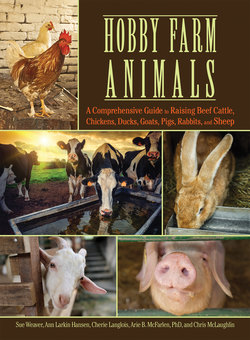Читать книгу Hobby Farm Animals - Chris McLaughlin - Страница 9
На сайте Литреса книга снята с продажи.
The Cattle Production Cycle
ОглавлениеThe life of a beef cow or steer follows a pretty standard pattern in most of the United States. After a calf is born, usually in the spring, the infant stays with the mother until it is weaned (between four and ten months of age). By weaning time, a male calf has been castrated and is ready to go on pasture or hay as a stocker calf, or backgrounder, for several months. An older calf may skip this stage and go directly on feed (presumably this is why all weaned calves are called feeder calves). On feed means putting young cattle in a pen instead of a pasture and feeding them a high-protein diet to accelerate growth and fattening. If the steer is an early-maturing breed and has been well fed, he may go to slaughter as young as sixteen months of age. If he is a slower maturing breed or is on a less intensive feeding program, he may be kept until age two or three.
Female, or heifer, calves intended for breeding are kept separate from their mothers and the bull after weaning, usually until they’re fifteen months old or a little older. At that point, they’re bred either by using a live bull or by artificial insemination, usually in midsummer of the year after they’re born. Nine and a half months later, if all goes as planned, they deliver their first calves and officially become cows, instead of heifers.
As long as a cow raises a good calf each year and doesn’t exhibit any major personality problems, she’s kept in the herd. When she becomes too old or infirm to get pregnant, the owner culls her. Sending a gentle old cow away to slaughter is difficult. I try to console myself with the knowledge that she had a full and happy life on our place and by arranging for her to go somewhere close and quick.
Bulls are usually kept in groups until they’re sold as breeding stock. The bull’s first calves will be delivered the next year, just ahead of breeding season, so it’s safe to use him for a second year. If you keep a bull for a third year, his daughters will be old enough for him to breed, so you will need to either make other arrangements for the heifers or get a new bull to prevent that from happening. Bulls can be sold to other cattle owners to give them a couple more happy years in the pasture or sent to slaughter.
| Body Condition Body condition scoring (BCS) is a simple method for assessing how fat or thin cattle are, which will help when you’re looking at cattle to buy or assessing the cattle you already have. BCS is a simple system, and you can start using it right away, but getting exact results takes experience. The optimum BCS for a cow is 5–7, or “pleasantly plump.” A cow’s body condition should be scored three to four months before calving, allowing time to adjust the ration and to let her gain or lose enough weight to be in optimum condition for calving and rebreeding. The numbers break down as follows: 1.Emaciated: No fat visible anywhere; ribs, hip bones, and backbone clearly visible through hide 2.Poor: Spine doesn’t stick out quite as much 3.Thin: Ribs visible; spine rounded rather than sharp 4.Borderline: Individual ribs not obvious; some fat over ribs and hip bones 5.Moderate: Generally good overall appearance; fat over the ribs and on either side of tailhead 6.High moderate: Obvious fat over ribs and around tailhead 7.Good: Quite plump; some fat bulges (pones) possibly visible 8.Unquestionably fat: Large fat deposits over ribs and around tailhead; pones obvious 9.Extremely fat: Tailhead and hips buried in fat; pones protruding |
This cattle production cycle creates a lot of opportunities to tailor your beef operation to your personal preferences and calendar. A cow-calf operator is on the job year-round, but it doesn’t take intensive management to keep cows and calves happy and productive. A backgrounder can buy feeder calves in the fall or the spring and keep them on forages until they’re ready for the feedlot. It’s quite easy with this system to have cattle only for the summer so that you don’t have to make or buy hay, and you can take the winter off. Feedlot operators can work on small amounts of land because they don’t need pasture; they do, however, need excellent management skills and a lot of knowledge about cattle nutrition.
Finally, seed stock producers, who raise bulls and heifers for cow-calf operations, must have plenty of experience with breeding high-quality cattle as well as good marketing skills.
